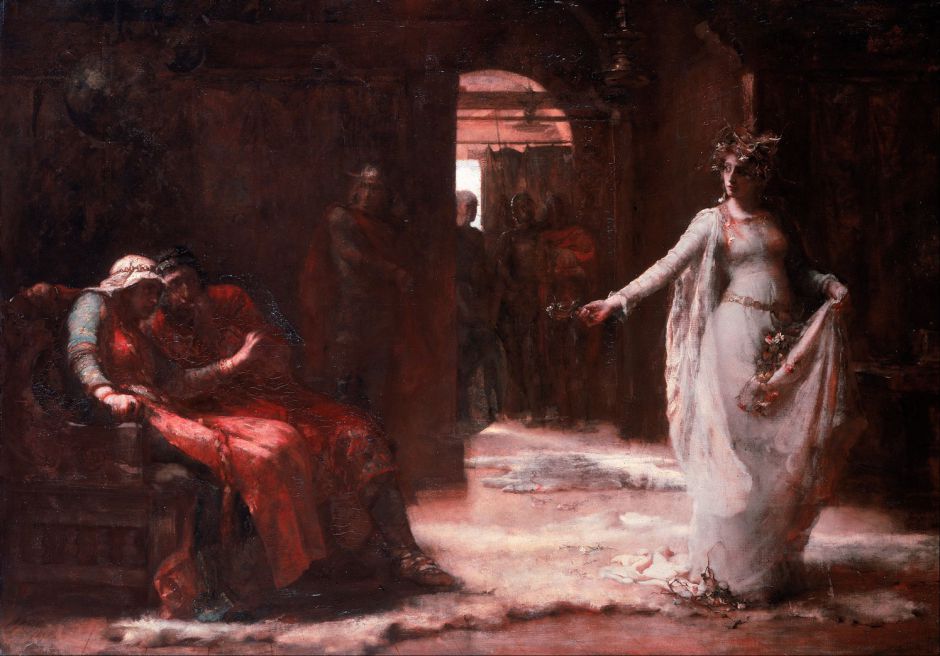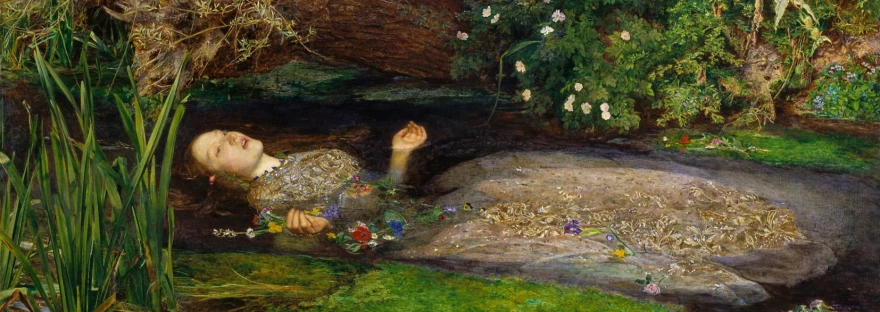Ophelia is one of the most famous female characters of Shakespeare’s plays. She is a young noblewoman of Denmark in the worldly acclaimed drama Hamlet. In the play, Ophelia is the daughter of Polonius, sister of Laertes and the potential wife of the Prince Hamlet.

Ophelia by Pierre Auguste Cot (1870) – Private Collection 
Ophelia by Ernest Hébert (19th century) 
Ophelia by Pascal Dagnan-Bouveret (1900)
The character of Ophelia has fascinated writers, painters, actresses and directors since she first appeared on stage. However, in the play, her tragedy is subordinated to that of the Prince Hamlet. It’s said that it is possible to imagine Prince Hamlet’s story without Ophelia, but she literally has no story without him. She appears in only five scenes of the play (which have in total 20 scenes) and Shakespeare gives very little information from which we can imagine a past for her, so it is impossible to reconstruct her biography from the play’s text, and too difficult even to create a story for her own.

Ophelia: Mental Health Theories and Feminism
Many scholars have considered Ophelia’s madness as a particularly female malady associating her to several theories and images of female insanity, especially the insanity in young women. Almost all of these theories contrast of masculine and feminine experience. According to them male madness comes from melancholy in association to intellectual or imaginative genius as we can see in Hamlet; while in women is associated to erotomania or love-madness, which is the case of Ophelia.

Ophelia by Delacroix (1853) – Musée du Louvre 
Ophelia by Cabanel (1883) – Private Collection
And despite all these, she is the most represented of Shakespeare’s female characters in painting, literature and popular culture. Over the past four centuries, she has achieved to get the centre of post-Shakespearean discourse becoming a female counterpart to Hamlet as a portrait of conflict. And recently she has become a strong feminist heroine, even surviving Hamlet in some fictional versions of the story.
Feminism have offered a new perspective to Ophelia. Feminists theories have seen in her madness a protest, a rebellion; according to them, the madwoman was a heroine who rebels against gender stereotypes or social order (or both) at enormous cost.

Ophelia by Henrietta Rae (1890) – Walker Art Gallery 
Ophelia by Henrietta Rae (1890) – Walker Art Gallery
Ophelia in Art
French poet Rimbaud wrote a poem inspired in Shakespeare’s Hamlet called Ophélie in 1870. The poem The Waste Land by T. S. Eliot, makes several allusions to Ophelia’s death as in the section below.
IV. Death by Water
Phlebas the Phoenician, a fortnight dead,
Forgot the cry of gulls, and the deep sea swell
And the profit and loss.
A current under sea
Picked his bones in whispers. As he rose and fell
He passed the stages of his age and youth
Entering the whirlpool.
Gentile or Jew
O you who turn the wheel and look to windward,
Consider Phlebas, who was once handsome and tall as you.

In painting, Ophelia was a popular subject especially during the 19th century, period in which we can find many depictions, most of them by British and French artists. Undoubtedly, Ophelia’s most famous depictions were made by Pre-Raphaelite artists as Millais or Waterhouse.

Among women artists I have found one sculpture and three paintings of Ophelia. One made by French painter Madeleine Lemaire and the others by English artists Margaret MacDonald and Henrietta Rae. The sculpture is by the famous actress Sarah Bernhardt.

Curiosities:
- Unlike all Hamlet’s characters, Ophelia’s name is not Danish, it probably derived from Ancient Greek word for “help” ὠφέλεια (ōphéleia).
- The second most inner moon of Uranos was named after Ophelia, it was discovered by Voyager 2 in 1986. It’s one of the smallest moon in the Solar System.










You must be logged in to post a comment.